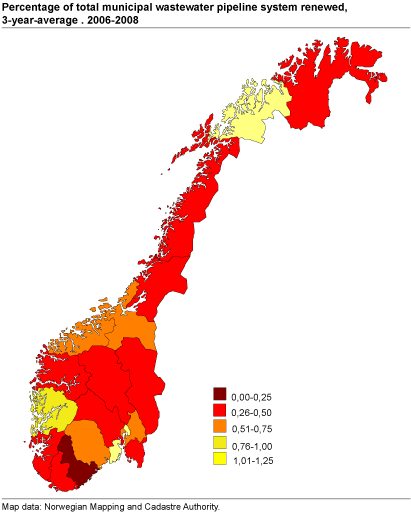Content
Published:
This is an archived release.
Ageing municipal wastewater pipelines
According to figures for 2008, the average age of municipal wastewater pipelines in Norway is estimated to be around 34 years - an increase of almost two years since 2006.
At present, the rate of installation of new wastewater pipelines is twice the rate of renewal of old pipelines systems. Nevertheless, the extent in 2008 is relatively small in relation to the existing pipeline system. It is estimated in 2008 that 318 kilometres of new wastewater pipelines were installed, corresponding to 0.90 per cent of the total existing pipeline system. By comparison, 160 kilometres of old wastewater pipelines were estimated to be renewed, equal to 0.45 per cent of the existing pipelines.
Renewal tends to vary from one year to another. The key figure “Percentage of total wastewater pipeline system renewed, 3-year average” will downsize these cyclical variations. The municipalities in the counties of Hordaland (1.12. per cent), Oslo (0.9 per cent) and Troms (0.88 per cent) renew the most, while Aust-Agder (0.23 per cent), Oppland (0.28 per cent) and Sogn og Fjordane (0.32) renew the least.
The renewal of wastewater pipelines is of critical importance to preventing damage to buildings and pollution to through leakages. Leaking pipelines can also contribute to higher treatment costs as surface water and groundwater can enter the pipelines.
“Half way around the world” with municipal wastewater pipelines
Estimations for 2008 show that there are around 35 200 kilometres of municipal wastewater pipelines in the whole country (not including separate storm water pipelines), which is equal to approximately 88 per cent of the circumference of the earth at the equator.
A total of 4.6 per cent of the municipal wastewater pipelines were installed before 1940, while 49.2 per cent were installed in 1980 or later. In addition, for 8.2 per cent of the pipelines, the installation date is unknown, but it is likely that they are old. The renewal rate for this category is relatively large at 2.38 per cent. By comparison, there was a 0.66 per cent renewal rate for wastewater pipelines installed before 1940 and a renewal rate of 0.12 per cent for pipelines installed in 1980 or later.
One pumping station every four kilometres
Pumping stations are sometimes used to direct wastewater against gravity (uphill etc). For 2008 it has been estimated that there are around 8 500 municipally-owned pumping stations in Norway; an average density of 0.24 pumping stations per kilometre.
Variation in standard of wastewater pipeline systems
According to the 2008 figures, there were 97 sewage overflows per thousand kilometre of municipal pipeline system in the country. This constitutes an increase of 14 per cent compared to 2007, but a decrease of 8 per cent compared to 2006.
The figures are not only related to the age of the pipeline systems, but there is a tendency that older pipelines give rise to more sewage overflows. In municipalities where the average age was below 25 years, the figure was 64 sewage overflows per thousand kilometre of pipelines, while this figure was 112 in municipalities with pipelines older than 50 years.
83 per cent of inhabitants connected to wastewater facilities of 50 pe or more
In 2008, it was calculated that there are around 83 per cent of inhabitants connected to municipal wastewater facilities of 50 person equivalents (pe) or more. Private solutions are most common among small wastewater facilities (less than 50 pe). The 1.2 per cent deviation between reported data on inhabitants connected and official population statistics - shown in the table - reflects the uncertainty in the reported data for inhabitants connected.
| Number of inhabitants | Percentage | ||||||||||||||||||||||||||||||||||||||
|---|---|---|---|---|---|---|---|---|---|---|---|---|---|---|---|---|---|---|---|---|---|---|---|---|---|---|---|---|---|---|---|---|---|---|---|---|---|---|---|
| Number of inhabitants connected to wastewater treatment plants 50 pe or more | 3 915 791 | 83.6 | |||||||||||||||||||||||||||||||||||||
| whereof connected to municipal wastewater treatment plants | 3 882 773 | 82.9 | |||||||||||||||||||||||||||||||||||||
| whereof connected to non-municipal wastewater treatment plants | 33 018 | 0.7 | |||||||||||||||||||||||||||||||||||||
| Number of inhabitants connected to wastewater treatment plants less than 50 pe or more | 765 675 | 16.4 | |||||||||||||||||||||||||||||||||||||
| whereof connected to municipal wastewater treatment plants | 121 157 | 2.6 | |||||||||||||||||||||||||||||||||||||
| whereof connected to non-municipal wastewater treatment plants | 644 518 | 13.8 | |||||||||||||||||||||||||||||||||||||
| Total number of inhabitants reported connected | 4 681 466 | 100.0 | |||||||||||||||||||||||||||||||||||||
| For comparison: official population statistics 01.01.2008 | 4 737 171 | 101.2 | |||||||||||||||||||||||||||||||||||||
| Deviation between connection to municipal wastewater plants and official population statistics | -55 705 | -1.2 | |||||||||||||||||||||||||||||||||||||
The statistics is now published as Municipal wastewater.
Contact
-
Gisle Berge
E-mail: gisle.berge@ssb.no
tel.: (+47) 48 12 19 97


